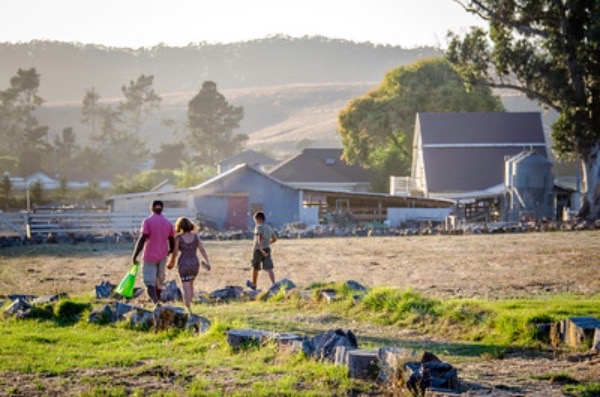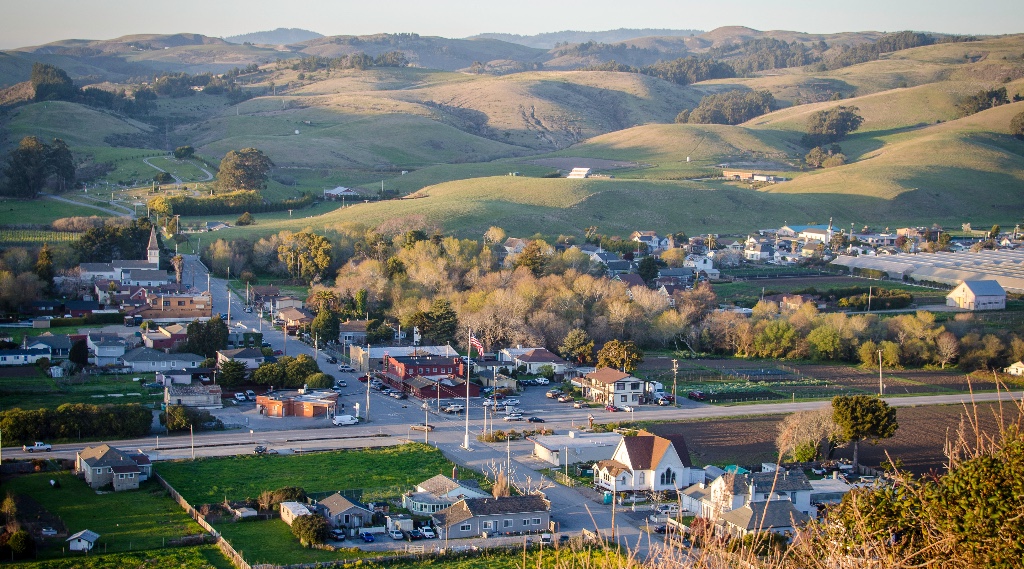
Chrissy McPhee grew up near the South Coast, where her grandparents owned a beautiful ranch that she let herself fantasize being able to purchase and raise her children on someday.
But when her grandparents needed to sell the ranch, McPhee couldn’t come up with the kind of money local ranches were fetching from outside buyers. A few years ago, they sold it to someone else – a woman McPhee’s age, who works in tech.
Now she and her husband rent a one-bedroom house near Pescadero for around $2,000 a month. Their eldest child sleeps in the living room, and they share a bed with their youngest. McPhee’s husband works six days a week in the trades, pulling in a decent wage while she takes care of the children. (Her name has been changed to protect her privacy).
It’s not ideal, but she’s in a far better situation than other local families she knows.
“It may be one bedroom, but we don’t have a crowd of people in our house, which is often the case for people here. Out here, your grown kids can’t move out because there’s nowhere to move out to.”
McPhee knows it’s true. Her family had to live with relatives while they waited to find something – anything – to move into that they could afford. It took them a year.
“Anything we looked at, we said ‘We’ll take it.’ It’s not like there’s any other options,” she says. Furthermore, $2,000 a month is now a good price for a one-bedroom in Pescadero, or anywhere on the Peninsula.
“We could never move anywhere else, because the rent has even gone up so high everywhere,” she says.
McPhee’s experience is hardly unusual. While market-rate housing is scarce to begin with on the South Coast, an area with little inventory, it’s squeezed by a real estate boom that has driven the cost of a one-bedroom cottage far above the $500,000 mark and made Pescadero and San Gregorio a part of the “million-dollar club” along with the likes of San Mateo, Foster City, Redwood Shores and Brisbane. In 2016, the average Coastside home price (the area stretching from Montara to Davenport) rose faster than the county’s overall.
Experts agree that tech billionaires and millionaires are driving the market with their appetite for property in the Peninsula’s final frontier — “a rustic paradise of redwood forests, farms and blustery beaches,” as the Mercury News described the South Coast last year in a story about gentrification. Open-space agencies contribute to the trend: preserving a property means taking land out of development, even as a future home to farm workers or teachers.
What’s left is a limited stock of rentals that are often cramped, dilapidated and beyond expensive.
“What’s not fair is these homes get sold, and our local workforce ends up living in overpriced apartments or modified trailers where they have to pay more than they can afford,” says Puente Executive Director Rita Mancera.
The struggles of middle-income residents like McPhee – who frequently have deep family roots on the South Coast stretching back generations – typically receive less attention from county officials than low-income farm workers, who are enduring their own housing crisis in overcrowded trailers and barracks that are well past their best-by date. A recent report from the Silicon Valley Community Foundation describes this crisis.
Several families often double-up in trailers and apartments that can barely hold a family of four. There is no designated affordable housing on the South Coast for low-income workers, and inventory pressures mean they are often forced to compete with higher-wage workers for the same small pool of market-rate housing.
The result is displacement. Mancera knows of three families in the past year alone that have given up trying to make a life for themselves on the South Coast, and moved to Sacramento.
They tell us, ‘My kids are finally going to have their own bedroom,’” she says.
This is a statewide issue. California lost 2.5 million economically disadvantaged residents to less-expensive states between 2005 and 2015, according to a recent analysis of U.S. Census data by the Sacramento Bee. In that same period, California attracted new, wealthier residents at a higher rate.
But in a small community like the South Coast, even incremental changes have unexpected ripple effects. Wealthier families with small children have created a problem by offering to pay some local childcare providers far more than farm worker families can afford. The result is that in some cases, these providers have stopped working for the low-income families, and are caring privately for the children of families who can afford more, says Mancera.
The La Honda-Pescadero Unified School District sometimes has trouble attracting a large pool of applicants when a new teacher is needed. The issue is affordability. Even if the teachers find something to rent on the South Coast, they know they won’t be able to put down roots.
“We have talented people who want to work at Puente and in our schools. I want them to be able to afford to live here so that they don’t have to go somewhere else,” says Mancera.
Furthermore, a lot of the families move to the South Coast and raise their kids here, but their kids are not enrolled district schools. They go to private schools on the peninsula’s Bayside.
Young, educated, talented professionals who grew up in Pescadero are learning the hard way you can’t go home again… or if you do, you can never leave.
“I know people who have graduated from college and who have a job over the hill, and they still live with family because they cannot find anything that is affordable, either here or on the other side of the hill,” adds Mancera.
Sometimes McPhee feels like there are two versions of Pescadero for two different kinds of people: tourists and the well heeled, versus residents like her.
“There’s no food store that you could buy things for affordable prices,” she says. “You always get the feeling it’s not for you.”
There is nothing wrong with wanting to have a nice place to live – a beautiful, safe place to raise your children. But Mancera has joined hands with Puente Strategic Projects Advisor Kerry Lobel to push for solutions that work for everyone – the newcomers and those who want to stay.
One of the most obvious solutions – to construct an affordable housing complex – would help lower-income workers, but benefit middle-class residents, too. “It would alleviate some of the crisis and bring prices down,” says Mancera.
But it faces difficult obstacles, including coastal zoning and building laws that tend to favor preservation of a “pristine” viewshed over modest proposals for multi-family housing. Officials from County Supervisor Don Horsley’s office have made the issue of Coastside affordable housing a priority, and they are working closely with county staff in Planning and Building, Environmental Health, Housing and Community Development and other departments to pursue every good lead on sites for new construction.
There is a community will to find solutions, but Mancera thinks the South Coast urgently needs funding to hire someone who will interface with all stakeholders, from local farmers to state officials, to get the best projects moving forward.
Puente is proposing a nonprofit spinoff that can manage vacant housing rentals. It would handle the leases and maintenance for South Coast vacation homes that sit empty for most of the year. The partnership could help homeowners with upkeep, while also keeping some local families from going homeless when they lose a rental.
Speaking for everyone, Mancera says: “We have got to be able to do something else besides knowing the crisis exists. My current fear is that we’ll be talking about these issues again in ten years, and saying we couldn’t fix them.”
McPhee says her plan is to try to live in Pescadero indefinitely – although her husband does talk about moving out of state. She wants her kids to grow up going to Pescadero schools with the same group of lifelong friends. She wants them to feel like they belong.
“I just wish there was a way people could stay,” she says. “It’s like you don’t know how much of your soul to invest in a place if you don’t know how long you’re going to be here.”
If you would like to support Puente’s rental assistance, social support, and regional planning programs, connect here: (Donate Link)

 For a clear picture of the housing crisis on the South Coast, meet Mira and Carlos Lopez. They and their three school-age children have not had a home since they were evicted from their apartment in September when their landlord needed to renovate the building. Mira’s brother Miguel was living with them too.
For a clear picture of the housing crisis on the South Coast, meet Mira and Carlos Lopez. They and their three school-age children have not had a home since they were evicted from their apartment in September when their landlord needed to renovate the building. Mira’s brother Miguel was living with them too.
